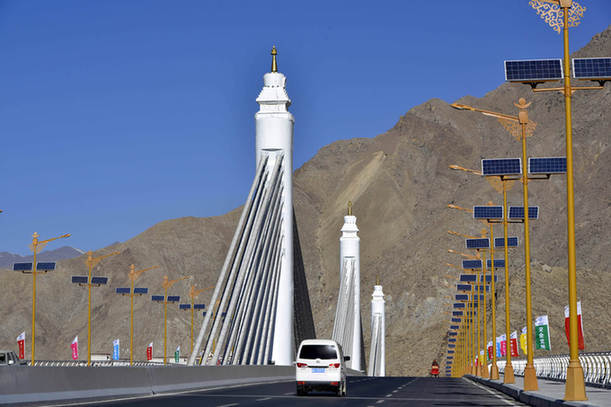Lhasa Transformed
Expanding the City
Lhasa first took shape as a city in the 17th century. In 1950 it had a population of merely 300,000 and an urban area no larger than three square kilometers. There were dirt roads and no sewers. Today urban Lhasa covers an area of over 60 square kilometers, 20 times bigger than 60 years ago.
Cao recalled that when he was a child, the main landmark in Lhasa was the Post and Telecommunication Office, and east of the building was nothing but croplands. “The so-called city proper referred to Jokhang Monastery and the Potala Palace. If you rode a bicycle, you could soon go around the whole city,” Cao said.
In 2011 the municipal government moved its office to the eastern suburbs of the city. On its heels came more businesses, residents and facilities. On the western side, the urban area has expanded across the Lhasa River to join with Doilungdeqen County on the other side of the river, where a new district has arisen to become the city’s second administrative center.
There are nearly 100 hostels and restaurants at Xianzu Island Resort by the Lhasa River, which is about two kilometers away from the Jokhang Monastery and the Potala Palace. On the other side of the river is the Princess Wencheng stage. Since its premiere in August, 2013, more than 210,000 people have seen this grand drama of Tibetan Opera, folk singing and dancing, set amid natural scenery.
There is a large construction site east of downtown Lhasa, which will soon become Tibet’s largest educational center. According to Jigme Namgyal, Lhasa’s vice mayor, the facility, at an investment of RMB 3.6 billion, will cover an area of 270 hectares upon completion, and 17 primary, secondary, professional and special education schools have already chosen to set up campus here. It will receive students later this year.
“In the past many families preferred to send their children to study in other areas,” said Qizhalha, Party secretary of Lhasa. “The construction of the educational center offers a new choice for local people.”
No to Polluters
In Lhasa there used to be a dark joke: in winter the only green is found at crossroads – the traffic light. But today, the city at an altitude of 3,650 meters is enlivened by large green spaces throughout the year. Over the past years it has planted along local roadways a variety of trees that can adapt to the plateau’s harsh climate.
In 2012 a large-scale greening project was launched on Nanshan Mountain on the southern bank of the Lhasa River. With a total investment of RMB 10 billion, the project introduced advanced technologies from Israel and the U.S. for reforestation in the region, which is expected to take about 10 years. The forest will play an important role in air purification, shielding wind and preventing erosion.
Meanwhile, conservation work has been started in the Lhalu Wetland, northwest of Lhasa. As the world’s highest and largest natural urban wetland, it is known as the “Green Lungs of Lhasa.” The city plans to invest RMB 700 million to resettle local residents and restore the ecosystem.
“Tibetans have always been in harmony with nature,” said Cao. “Countless migratory birds, such as wild ducks and black-necked cranes, fly to the wetlands to pass the winter.”
However, Lhasa is also a victim of global warming. Sixty-year-old Kelsang Phuntsog remembers being able to see stars every night. Now they are rarely visible, and the mountain snows are slowly melting. Even so, Lhasa still leads the country in air quality.
Regarding environmental protection, Qizhalha says, “We say no to any polluting enterprise.” He added proudly that there are no polluting enterprises within 1,000 kilometers of Lhasa. On a recent visit to Namtso Lake, he remarked that the scenery there was as pristine as the South Pole. “We must keep this holy land as it has always been,” he said.
 |
| Lhasa’s Nachen Bridge is open to traffic on November 27, 2013. |
